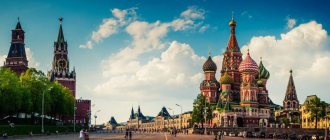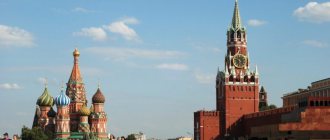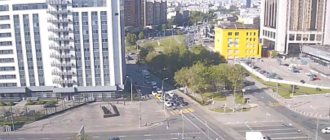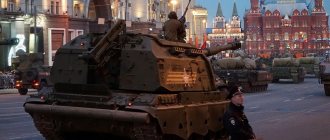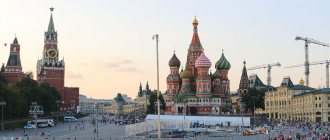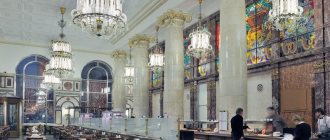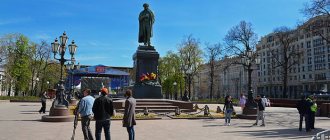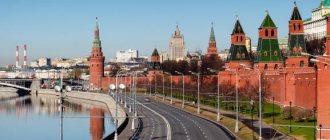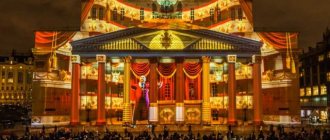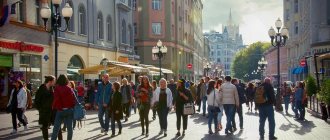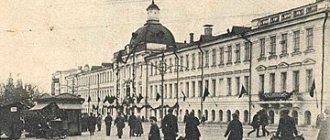Manezhnaya Square is located in the center of Moscow, close to the Kremlin and other recognizable historical attractions. The modern territory of the square, formed in 1937, included the former Moiseevskaya Square with Obzhorny and Loskutny lanes, sections of adjacent streets and a dead end.
Currently, Manezhnaya Square remains one of the most visited places by tourists after the neighboring Red Square. The appearance of Manezhnaya Square was largely shaped by the sculptor and painter Zurab Tsereteli, whose sculptural compositions adorn the fountains.
Under the square there is the territory of an underground three-story shopping mall, a very remarkable place in the center of Moscow.
© Yaroslav Glukhov
Photo gallery
Alexander Garden and monument to Prince Vladimir
The Alexander Garden is located in the very center of the capital, near the walls of the Kremlin. Today it is a beautiful, well-kept park with monuments reminiscent of historical events and the military glory of the country. The place owes its name to Emperor Alexander I. By his order, the Neglinnaya River was buried underground, and in its place gardens were laid out to perpetuate the memory of the victory in the war of 1812 and for public festivities.
The park was designed by the architect O. Bove. He also built one of the main attractions of the garden - the Italian Grotto. The attention of tourists is attracted by the obelisk monument of the Romanovs, the fountain complex, and the Kutafya Tower.
The most significant place in Alexander Park is the Eternal Flame near the Tomb of the Unknown Soldier. The memorial complex is a symbol of the majestic feat of those who fought for peace and freedom during the Great Patriotic War. The Eternal Flame is guarded by the Honor Guard. Its hourly shift always attracts a large number of tourists.
The newest sculpture, located at the end of the garden, is a monument to the Kyiv prince Vladimir, who baptized Rus'. It was opened in 2016. Architect Salavat Shcherbakov created a powerful sculpture of the prince with a cross raised high into the sky, indicating the path to true faith. The gentle steps are reminiscent of the waters of the Dnieper, where the baptism ceremonies of the first Christians of Ancient Rus' took place.
Manezhnaya Square
It received its final appearance only in the 30s of the last century. The name of the place was obtained due to the exhibition located on it. It was erected in the style of classicism. Over the 200 years of its history, the building of the modern exhibition center has been a place for drill training, a concert hall, a stable and even a garage. Today, exhibitions, concerts and other public events are regularly held here.
Shopping lovers will certainly visit the largest shopping mall, built according to the design of Zurab Tsereteli. From the end of April every year, fountains begin to operate on the square. The most famous of them is “The Four Seasons,” depicting horses rushing forward. People make dates near the fountain, make wishes and, of course, take unforgettable photos.
Manezhnaya Square, Moscow. Five centuries ago, other people not only lived in this place: there wasn’t even a square here! It is all the more interesting to walk through the pages of the history of one of the centers of trade and craft in the capital.
Public events and events
View of Manezhnaya Square, 2015.
Manezhnaya Square has repeatedly become the venue for mass rallies and demonstrations. The square hosted the most numerous protests of the perestroika and post-Soviet times: on February 4, 1990, a rally was held here demanding the abolition of the sixth article of the USSR Constitution, which attracted up to 300 thousand people. On January 14, 1991, more than 100 thousand people came to Manezhnaya under the slogan “We will not allow the occupation of Lithuania!” During the August putsch, Manezhnaya became one of the places of mass demonstrations by opponents of the State Emergency Committee[22].
On August 31, 1999, an explosion occurred on the third tier of the Okhotny Ryad shopping center, as a result of which one person was killed and more than 30 were injured[23].
On June 9, 2002, mass riots occurred in the square as a result of the defeat of the national team in the match with Japan during the World Cup[24].
On December 11, 2010, riots broke out again at Manezhnaya. Their cause was the murder of Spartak fan Yegor Sviridov and the procedure for investigating the crime[25].
Manezhnaya Square is also a venue for open-air concerts and performances: in 1997, The Prodigy performed at this place, attracting about 250 thousand people, and in 1998, a concert by rapper Coolio took place[26][27].
Early period
Nowadays Manezhnaya Square refers to a vast area not far from the Kremlin and the Alexander Garden. This includes the former Moiseevskaya Square, Loskutny and Obzhorny lanes and the dead end of Mokhovaya, Tverskaya, Bolshaya Nikitskaya and Manezhnaya streets.
Previously, the place was called “Zaneglimenye” - that is, a settlement beyond the Neglinnaya River. The first residential areas date back to the 12th and 13th centuries. Two hundred years later, this part of the capital became so densely populated that fires often occurred here. For security reasons, Ivan III ordered the demolition of all wooden buildings located at a distance closer than 109 fathoms from the Kremlin. Thus, the current Manezhnaya Square remained empty until the 16th century.
1566 Ivan the Terrible divides the state into zemshchina and oprichnina. The latter also included the south of Zaneglimenye. After another fire in the Oprichnina courtyard, the Moiseevsky Monastery was built here. In the 17th and early 18th centuries, Zaneglimenye began to revive again: this was facilitated by the policies of the Romanovs and, in particular, Peter I, who transferred the Okhotny and Kharchevoy ranks here. The square became the center of market trade in Moscow, there was always a crowd here, and crafts flourished.
At this time, the square is called Okhotny Ryad - the largest shopping pavilion. Despite the proximity of the convent, these places did not acquire the best reputation: next to the busy market there were taverns and lodging houses of the lowest category. The government tried to restore order here and proposed organizing a large indoor market, like in European capitals. However, the merchants, who had huge profits from “spontaneous trade,” did not want to change the situation and resisted reforms.
Old building of Moscow University
Across the road from the Manege are the yellow buildings of Moscow State University, built in 1793. It is considered one of the finest works of Russian neoclassicism and Matvey Kazakov, who died shortly after the fire of 1812 that destroyed many of the buildings he designed. The university was restored, bas-reliefs and lion heads served as a nice addition to the impressive facade.
Moscow State University building on Mokhovaya
In front of the building is a monument to Herzen and Ogarev, two graduates who were among the founders of the revolutionary tradition in 19th-century Russia. On the other side of Bolshaya Nikitskaya Street there are “new” university buildings that date back to 1836. The round building on the corner was originally the chapel of St. Tatiana, the students' favorite saint, until it was closed after the revolution; the chapel was returned to the church in 1994.
Main building of Moscow State University
In front of the main building of the university is a monument to Mikhail Lomonosov, who founded Moscow State University in 1755. Among the low buildings behind the university stands the bell tower of the Church of the Sign at Sheremetyevo Yard, a fine example of 17th-century Moscow baroque style with a filigree spire. During the reign of Ivan the Terrible, there was the Oprichnina Court, a large fortified palace.
Hotel National
Manege
The Manege building was an indoor building for military combat training. The opening of the building coincided with the five-year anniversary of the victory over Napoleon's troops - Alexander I was present. In 1831, the Manege began to be used as a venue for concerts, balls, exhibitions of circus performances and folk festivals. Since 1917, a barracks was organized here, and then a garage for government cars. Now the building has been given the status of the Central Exhibition Hall. The arena was reconstructed in 2004 after a major fire.
Literature
- Veksler A.G.
Manege and Manezhnaya Square in Moscow: Horizons of history. - M.: Veche, 2012. - 144 p. — 3000 copies. — ISBN 978-5-9533-4664-1. - Vaskin A. A., Golstadt M. G.
From the demolished Voentorg to the burnt-out Manege. Historical photo guide. - M., 2009. - 400 p. — 2000 copies. — ISBN 678-5-9973-0100-2. - Muravyov V.B.
Moscow streets. Secrets of renaming. - M.: Algorithm, Eksmo, 2007. - 336 p. — ISBN 978-5-699-17008-1. - Sytin P.V.
From the history of Moscow streets. - M., 1958.
XXth century
1931 - the beginning of noticeable changes in the former Zaneglimenye, caused by the implementation of the General Plan for the Reconstruction of Moscow. The square in front of the southern facade of the Manege takes its name, and the shops of Okhotny Ryad are demolished due to the construction of the highway to the Palace of Soviets and the metro. By 1938, not a single building remained on this territory, and in 1940-1990. The manezhka was not built up. It was used as a parking lot for tourist buses, and in the 90s Muscovites organized rallies here against the Soviet regime.
in 1967, the square was renamed in honor of the 50th anniversary of the October Revolution, but it carried this name only until 1990, when it was given back its historical name. The Soviet government even planned to erect a monument in honor of the holiday, but the matter never moved beyond the foundation stone.
Story
History of the area
Fragment of the plan of Moscow in 1610.
In the center, to the right of the Resurrection Bridge over the Neglinnaya River, is the 16th-century Moiseevsky Monastery. Manezh and Manezhnaya Square are located on a place that was historically called Zaneglimenye - across the Neglinnaya River. The first suburban settlement on the right bank of the Neglinnaya appeared in the 12th-13th centuries. Despite the swampy soil, by the second half of the 15th century this part of Moscow was already densely populated, and therefore fires regularly occurred here. After another major fire in 1493, Tsar Ivan III ordered the demolition of all wooden buildings at a distance of 109 fathoms from the Kremlin walls, after which the space on the site of the current square was empty until the middle of the 16th century[8][9].
In 1566, Ivan IV ordered the entire state and its capital to be divided into oprichnina and zemshchina. As a result of this division, the southern part of Zaneglimenye entered the oprichnina. But the newly built Oprichnina courtyard did not last long: in 1571, the royal residence almost completely burned down. Later, in the northwestern part of modern Manezhnaya Square, the Moiseevsky Monastery was founded, abolished in 1765 by Catherine II[10][11].
In 1599, during the reign of Boris Godunov, the Zemsky Dvor was erected opposite the former Oprichnina Court. In this area there was also a settlement of the Stremyanny Streltsy Regiment. When the Streltsy regiment and the settlement were disbanded in 1698, this territory began to be given away for ownership and lease. In 1707-1708, by decree of Peter I, earthen fortifications began to be erected around the Kremlin and Kitai-Gorod, and the Kharchevoy and Okhotny ryads were transferred to the land of the former settlement[2][12].
In the second half of the 18th century, projects were developed to reorganize the center of Moscow; in particular, it was decided to create a chain of new squares. The implementation of this plan was facilitated by the Moscow fire of 1812, which destroyed many buildings in the historical center. In place of the bed of the Neglinnaya River, which was enclosed in an underground reservoir in 1819, Alexander Park was built along the western wall of the Kremlin. An important part of the post-fire reconstruction was the construction of the Manege building[13].
Construction of the Manege
Main article: Manege (Moscow)
By order of Emperor Alexander I, Exertsirgauz (the first name of the Manege) was erected on the resulting square - a covered pavilion for drill training of troops. The construction was carried out by a group of engineers under the leadership of General Lev Carbonnier according to the design of Augustine Betancourt and Auguste Montferrand. The emperor was present at the opening of the building, dedicated to the fifth anniversary of the victory over Napoleon. Since 1831, the Manege began to be used for exhibitions, folk festivals, as well as balls and concerts[14]. After the revolution, a barracks was built in Manege, and after the end of the Civil War, a garage for government cars was built. Since 1967, Manege has the status of the Central Exhibition Hall. In 2004, there was a major fire, after which the building was reconstructed[15].
Throughout the 19th century, the area around the Manege was densely built up. Neglinnaya Street ran between the eastern facade and the Alexander Garden, and the western facade faced Mokhovaya. The southern part is on the square in front of the Kutafya Tower, the northern part is on Bolshaya Nikitskaya Street and abuts the block between Neglinnaya and Mokhovaya[16][1][2].
Creation of Manezhnaya Square
In 1931, the square in front of the southern facade of the Manege (near the Kutafya Tower) received the name Manezhnaya. The liberation and clearing of the square space at the northern façade of the Manege lasted from 1932 to 1938. In 1932, in connection with the construction of the first line of the Moscow metro, demolition of the old quarter along Loskutny Lane and Mokhovaya Street began, which was completed by 1934. In its place, two tunnels were built for the service connecting branch between the modern Sokolnicheskaya and Filyovskaya lines[2][17][18].
In connection with the anniversary of the October Revolution in 1967, Manezhnaya was renamed the Square of the 50th Anniversary of the October Revolution and was called that until 1990, when its original name was returned[1][2][18].
| Manezhnaya Square | |||||||||
| Place of the future Manezhnaya Square in the 19th century | |||||||||
| View of the future Manezhnaya Square, 1931 |
| View of Manezhnaya Square and the Moscow Kremlin, 2011 |
| Mokhovaya street. View of Manezhnaya Square and the Kremlin, 2013 |
Construction of the underground shopping complex “Okhotny Ryad”
Main article: Okhotny Ryad (shopping complex)
St. George the Victorious on the dome of the Okhotny Ryad shopping center, 2010.
In 1993, Manezhnaya Square was cleared of traffic and construction of the Okhotny Ryad underground shopping complex began underneath it. Construction of the complex was completed on the day of celebration of the 850th anniversary of the city in 1997[2]. Initially, the architectural studio of Boris Ulkin won the competition for the development of Manezhnaya, but subsequently the reconstruction was carried out according to the Mosproekt-2 project with the participation of sculptor Zurab Tsereteli. The cascade of fountains in the Alexander Garden, part of the Okhotny Ryad shopping complex, was built in the security zone of the World Heritage Site - the Moscow Kremlin[19]. According to art historian and architectural critic Grigory Revzin, the construction of Okhotny Ryad practically destroyed Manezhnaya Square[20].
The underground shopping and recreational complex has a polygonal elongated shape and is located between the metro tunnels. The length of the structure is about 300 meters, width - 137.5 meters. The total area is about 70 thousand m²[21].
Construction of Okhotny Ryad
1993 The territory of Manezhnaya Square becomes pedestrian, and its development begins under the Mosproekt-2 project.
The Okhotny Ryad complex consists of three underground floors and one above-ground level, consisting of terrace areas connected by stairs. The center's calling card is a glass dome with a sculpture of St. George the Victorious. The construction of the complex took seven years, and its opening coincided with the 850th anniversary of Moscow. This also includes the most beautiful cascading fountains created by Z. Tsereteli in the Kremlin area.
Okhotny Ryad is classified as a shopping and recreational complex. It is located between metro stations and has an oblong shape. The total area of the center is 70 thousand m2. Each underground level is decorated in its own style: from the aesthetics of the 17th century to classicism and then to modernism. The exterior design is also worth mentioning: the lanterns, sculptures and 12 fountains by Zurab Tsereteli are amazing. Here you can see fairy tale heroes and the famous four horses - symbols of the seasons. The main fountain of Manezhka is called “Geyser”.
During the construction of the complex, valuable from an archaeological point of view fragments of wooden pavement, treasures, and the remains of the Resurrection Bridge were found underground. They served as the basis for the exhibition of the Archaeological Museum, built in 1997.
Notes
- ↑ 1 2 3 Ekaterina Shalygina.
Manezhnaya Square
(undefined)
. Get to know Moscow. Retrieved August 30, 2021. - ↑ 1 2 3 4 5 6
Manezhnaya Square
(undefined)
. City portal of Moscow. Retrieved August 30, 2021. - Moscow: all streets, squares, boulevards, alleys / Vostryshev M. I. - M.: Algorithm, Eksmo, 2010. - ISBN 978-5-699-33874-0.
- ↑ 1 2
Manezhnaya Square
(unspecified)
. Culture.rf. Retrieved September 6, 2021. - Manezhnaya Square (undefined)
. Holidays and weekends in Moscow. Retrieved September 6, 2021. - Manezhnaya Square in Moscow (undefined)
. life-globe (February 8, 2016). Retrieved September 6, 2021. - Manezhnaya Square (undefined)
. Subtleties of tourism. Retrieved September 6, 2021. - Wexler, 2012, p. 18-21.
- Sytin, 1958, p. 170.
- Wexler, 2012, p. 22-27.
- Sytin, 1958, p. 171-172.
- Wexler, 2012, p. 22-29.
- Wexler, 2012, p. 32-33.
- Wexler, 2012, p. 50-51.
- Wexler, 2012, p. 52.
- Suprunenko Yu. P.
Moscow underground. The crown and roots of the great mystery. - M., 2015. - ISBN 978-5-699-33874-0. - Vaskin, Golstadt, 2009, p. 240-245.
- ↑ 12
Muravyov, 2007, p. 277-278. - The keeper. Alexey Ilyich Komech and the fate of Russian architecture / Samover N. - M.: Art - XXI century, 2009. - ISBN 978-5-980-51-060-2.
- Revzin G.I.
Okhotny Ryad is open to the very depths
(unspecified)
. Kommersant (December 11, 1997). Retrieved August 30, 2021. - Shopping complex "Okhotny Ryad" on Manezhnaya Square (unspecified)
. Mosinzhproekt Institute. Retrieved August 30, 2021. - The most massive protests in Moscow since 1990. History of the issue (undefined)
. Kommersant (December 10, 2011). Retrieved August 30, 2021. - 15 of the worst Moscow terrorist attacks (unspecified)
. Big Picture (June 10, 2013). Retrieved August 30, 2021. - Angry fans destroyed the center of Moscow (unspecified)
. newsru.com (June 9, 2002). Retrieved August 30, 2021. - Riots on Manezhnaya Square in Moscow on December 11, 2010 (unspecified)
. RIA Novosti (December 11, 2015). Retrieved August 30, 2021. - Prodigy concert on Red Square (unspecified)
. The Prodigy (September 27, 1997). Retrieved August 30, 2021. - Alena Skvortsova.
Five free shows that Moscow will never forget
(unspecified)
. 360°. Retrieved August 30, 2021.
What else to see on Manezhnaya Square?
In addition to the Archaeological Museum and Okhotny Ryad, the facade of the Historical Museum overlooks Manezhnaya Square. Opposite its entrance in 1995, a monument to Marshal Zhukov by V.M. was erected. Klykov, belonging to the direction of socialist realism. Since then, it has often been designated as a meeting point for Muscovites and guests of the capital.
In 1996, the “Zero Kilometer” sign appeared on Manezhnaya Square - the starting point for Russian highways. Tourists love the attraction: they believe that a coin thrown here will definitely bring them to Moscow again.
You can also see here the Resurrection Gate, restored in the 90s, with the chapel of the Iveron Mother of God.
Other attractions
Before entering Tverskaya Street, look at the buildings connecting Manezhnaya Square with Okhotny Ryad Street. On the left corner stands the National Hotel, an eclectic building with tiled friezes, the most beautiful hotel in Moscow before the revolution.
The State Duma
In 1918, before moving to the Kremlin, Lenin lived at No. 107; Party functionaries and country-friendly Council of Travelers such as John Reed and Anatole France were stationed here. After restoration in the 1990s, the National competed with the Metropol for the title of the main hotel in Moscow; the windows of the National's rooms offered stunning views of the Kremlin.
House of Unions
At the far end of Tverskaya Street looms a gray 1930s building built for Gosplan, the ministry that served as the overseer of the Soviet economy that is now performed by the State Duma, the lower house of the Russian parliament. The building is completely overshadowed by the neighboring Union House, a green and white 1780s neoclassical building that housed the Noble Assembly before the Revolution.
Restaurant "Planet Sushi"
During Soviet times, its glittering Hall of Columns was used for show trials, and the funeral ceremonies of Lenin and Stalin took place here. The line of people wishing to say goodbye to Lenin did not end for three days and nights, despite the bad weather; To this day, no one knows how many people were crushed in the crowd at Stalin’s funeral - the approximate number is 1,500 people.
